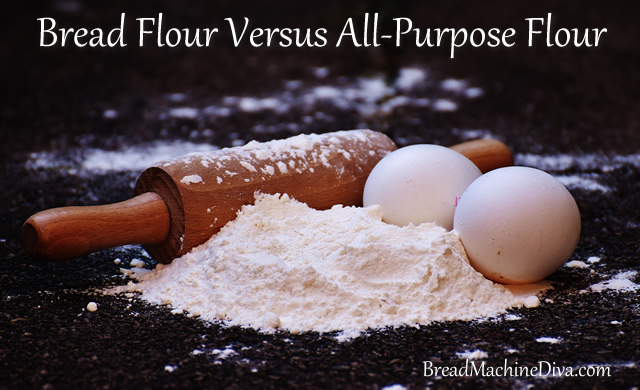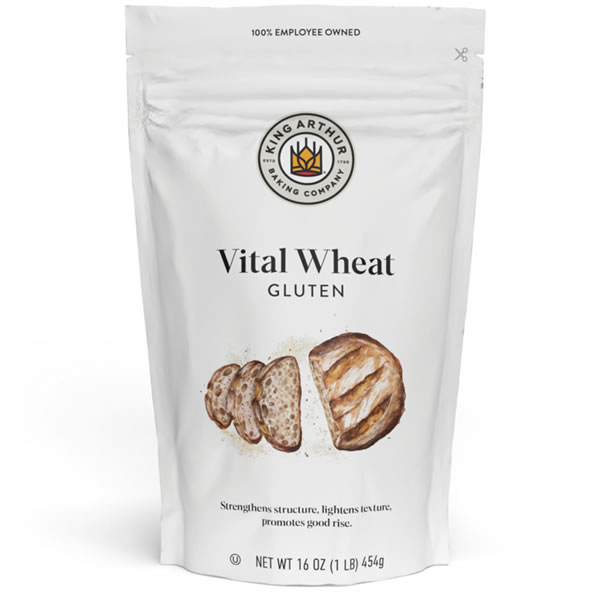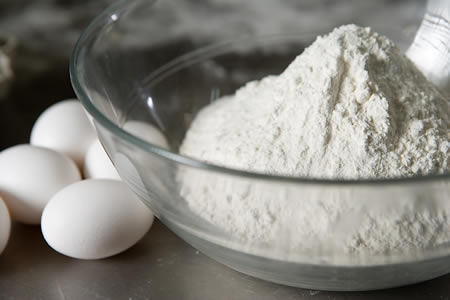Bread Flour Versus All-Purpose Flour

Last Updated on November 6, 2021 – Originally posted on September 21, 2009
Many people use all-purpose flour in bread making instead of bread flour. I started wondering what the difference is. It turns out that the difference is gluten.
Gluten is a type of protein found in flour.
More gluten in the flour makes the bread slightly heavier, but more importantly, it makes it stronger. That means that as the yeast ferments, the bread will hold the carbon dioxide and rise.
If the dough isn’t strong, then the carbon dioxide will escape and the bread won’t rise as high.
Bread flour has more gluten than all-purpose flour. However, the amount of gluten in particular brands of flour varies.
In general, all-purpose flour has a gluten content of 9% to 12%. Bread flour typically has a gluten range of 10% to 13%. Note the overlapping areas.
If you’re using all-purpose flour in your bread machine and it works for you, that’s great. Your brand of flour must be in the upper range of the gluten levels.
What if You Only Have All-Purpose Flour?
Look at the packaging to see if the gluten content is high enough for use in the bread machine.
Check out the website of the manufacturer of the all-purpose flour. It may have the gluten percentage of the flour there.
If the gluten percentage isn’t listed or it gives a range, then make an experimental loaf of bread. The worst that will happen is that the bread won’t rise as high as normal.
Even if your all-purpose flour doesn’t have enough gluten, it’s okay to use it in the bread machine. Again, the worst that will happen is that your bread won’t rise as much as it would have with bread flour.
Vital Wheat Gluten to the Rescue!
If your all-purpose flour doesn’t have enough gluten, don’t worry. You can fix that by using vital wheat gluten.
At my grocery store vital wheat gluten is in the Bob’s Red Mill area. If you order it online, check out King Arthur Flour’s vital wheat gluten. (You can never go wrong with their products!)
While vital wheat gluten looks like flour, it’s not. It’s basically powdered gluten.
Add one teaspoon of vital wheat gluten per cup of flour. For example, if the recipe calls for 4 cups of bread flour, then add 4 teaspoons of vital wheat gluten.
Note that you may need to experiment with the amount of vital wheat gluten needed.
If you add vital wheat gluten, be sure to take a look at your dough a few minutes after it starts kneading. You may need to add a little liquid. Also, if the bread doesn’t rise enough, you may need to add a little more vital wheat gluten on your next loaf of bread.
Wondering about other types of flour?
Cake Flour has the lowest gluten content of all. Its gluten content is in the 5% to 8% range. Cake flour is generally bleached. The bleaching slightly damages the flour’s starches as well as weakening the gluten. This enables the flour to absorb more liquid and rise higher.
Cake flour is used for cakes and other baked goods that are soft and tender. Cake flour is not recommended for making bread.
Pastry Flour is sometimes called cookie flour. It has a gluten content of 8% to 9%. It’s frequently used for pies, tarts and many cookies.
Like cake flour, pastry flour is not recommended for making bread.
You can make your own pastry flour by mixing together 1 1/3 cups all-purpose flour with 2/3 cup cake flour.
Self-Rising Flour contains baking powder and salt. This staple of Southern cooking is used for biscuits, muffins, and pancakes.
You can make your own self-rising flour by combining 1 cup all-purpose flour with 1 1/2 teaspoons baking powder and 1/4 teaspoon salt.
Whole-Wheat Flour is called wholemeal flour in the UK. It’s made from the whole kernel of wheat.
Whole-wheat flours are high in protein but have problems forming gluten. That’s why many recipes for whole-wheat bread call for the addition of vital wheat gluten.
Gluten-Free Flour isn’t made from wheat. There are many types of gluten-free flour. Some of the most popular types are almond flour, buckwheat flour, and sorghum flour.
Since bread depends on gluten, making bread with gluten-free flours is a challenge. It’s a whole different type of baked good.




